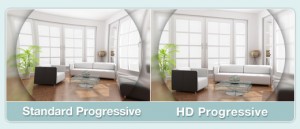If the print keeps getting smaller, you may have presbyopia, a common condition that can be corrected with multi-focal glasses or contact lenses.
The invention of bifocals is credited to Benjamin Franklin in the late 1700’s – that is some old technology. Flat-top or lined bifocals are still available and function well in certain situations. Another alternative to the lined bifocal are progressive lenses. Progressives feature an intermediate or “transition region” that allows your eyes to focus in the area in between near and far distances (a computer screen for example). Progressives, or “no-line bifocals,” have a gradual curvature across the lens surface and provide not only clearer vision at near and far distance, but also smooth, comfortable transitions in between.

Today you can find factory molded progressive lenses at many major retailers and even on the internet. These old-school progressive lenses are made for average prescription powers, standard fitting parameters and limited frame sizes. Fortunately, all progressive lenses are not created equal.
New technology takes the way we use our eyes and the optics of different prescriptions into consideration with the newly designed progressive lenses. More precise and individualized manufacturing provide smoother transitions and wider viewing zones with the elimination of blurring and swaying sensations in the peripheral vision. Free-form or digital high definition lenses utilize computer controlled surfacing. The position of the lens in the frame and the way the frame fits on the wearer’s face are all measured and considered in addition to the prescription.
At Westside Optometry we want to find the best lens design for your lifestyle and visual demands. Sunglasses are available in the new technology too.
One thought to “Progressive Lenses”
Comments are closed.